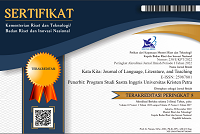Increasing PyonPyon’s Instagram Traffic through Livestreams
(1) Petra Christian University
(*) Corresponding Author
Abstract
PyonPyon is a start-up company in Jakarta that runs on the healthy-beverage industry. During the author’s final assessment internship, PyonPyon was having trouble on getting traffic or even public exposure on their main social media account, Instagram. The author then identified PyonPyon’s problem as low traffic and public exposure on their main social media marketing. Therefore, a solution was implemented by putting PyonPyon on an endorsement through live streamers and posting unique Instagram post. Supporting the solution, the author needs to know the level of brand awareness and consumer’s buying behavior. Thus, a survey was created to 36 respondents from across Indonesia. From the questionnaire, result showed that PyonPyon’s brand awareness is currently at the lowest stage, which is “unaware of brand”. After the survey and implementing the solution, result showed that by putting PyonPyon on live streamers that has decent live views, it can raise the Instagram traffic of PyonPyon. The author decided that endorsement in live streams is a good way to gain traffic and to gain public exposure, also increases PyonPyon brand awareness, since the target market, or the live viewers can check out PyonPyon’s Instagram and product at the same time while it is shown on the show. The author created a strategy by applying theories such as measuring levels of brand awareness from Aaker (1991), methods to increase brand awareness from Liando and Setyawati (2014), social media marketing from Hayes (2021), and advertising from Yakup (2011).
Keywords
Full Text:
PDFReferences
Aaker, A.D. (1991). Managing Brand Equity, Capitalizing on the value of a Brand Name, New York, Free Press. 348.
Ahmad, Nur Syakirah & Musa, Rosidah & Harun, Mior. (2016). The Impact of Social Media Content Marketing (SMCM) towards Brand Health. Procedia Economics and Finance. 37. 331-336. 10.1016/S2212-5671(16)30133-2.
Anjani, H., Irham, I., & Waluyati, L. (2019). Relationship of 7P Marketing Mix and Consumers' Loyalty in Traditional Markets. Agro Ekonomi, 29(2), 261. https://doi.org/10.22146/ae.36400
Breuer, C. and Hallman, K., 2011. return on marketing investments/economics of sponsorship. [ebook] Christoph Breuer, pp.1609 - 1610. Available at: https://www.researchgate.net/publication/256389118_Unique_selling_propositon_USP
Bobrov, D. (2016). Basic Marketing with Haaga Helia Courses. Available at: http://simplemarketingsteps.blogspot.fi/2016/08/product-offering.html
Caldieraro, F., & Cunha, M. (2021). Consumers’ response to weak unique selling propositions: Implications for optimal product recommendation strategy. International Journal Of Research In Marketing, 1. https://doi.org/10.1016/j.ijresmar.2021.11.003
Cronje, GJ, Du Toit GS, Motlatla, & MDC, Marais, A de K. 2007. Introduction to Buiness Management. 6th edition.Cape Town: Oxford University Press, p. 283
Durmaz, Yakup. (2011). A THEORETICAL APPROACH TO THE CONCEPT OF ADVERTISING IN MARKETİNG. International Journal of Economics and Research ( IJER),. 2. 46-50.
Gustafson, T., & Chabot, B. (2007). Brand Awareness. Cornell Maple Bulletin , 105.
Harrington, R., Ottenbacher, M., & Fauser, S. (2017). QSR brand value. International Journal Of Contemporary Hospitality Management, 29(1), 551-570. https://doi.org/10.1108/ijchm-06-2015-0300
Kukanja, M., Omerzel, D. ., & Kodrič, B. (2016). Ensuring restaurant quality and guests’ loyalty: an integrative model based on marketing (7P) approach,. Total Quality Management & Business Excellence, 1–17.
Kushwaha, G., & Agrawal, S. (2015). An Indian customer surrounding 7P׳s of service marketing. Journal Of Retailing And Consumer Services, 22, 85-95. https://doi.org/10.1016/j.jretconser.2014.10.006
Liando, M., & Setyawati, C. (2014). STRATEGY TO IMPROVE BRAND AWARENESS. Journal Of Management And Business, 13(1). https://doi.org/10.24123/jmb.v13i1.239
Marques, A., Lacerda, D., Camargo, L., & Teixeira, R. (2014). Exploring the relationship between marketing and operations: Neural network analysis of marketing decision impacts on delivery performance. International Journal Of Production Economics, 153, 178-190. https://doi.org/10.1016/j.ijpe.2014.02.020
Reeves, R. (1961). Reality in advertising.
Romaniuk, J., Wight, S., & Faulkner, M. (2017). Brand awareness: revisiting an old metric for a new world. Journal Of Product & Brand Management, 26(5), 469-476. https://doi.org/10.1108/jpbm-06-2016-1242
What Is a Brand?. Investopedia. (2022). Retrieved 8 February 2022, from https://www.investopedia.com/terms/b/brand.asp.
Tjiptono, F., & Chandra, G. (2005). Service, Quality, and Satisfaction. Yogyakarta: Penerbit Andi.
DOI: https://doi.org/10.9744/katakita.10.3.594-600
Refbacks
- There are currently no refbacks.
Supported by:
Indexed in:
Tools:
Stats (installed since 17 December 2018)
View My Stats













